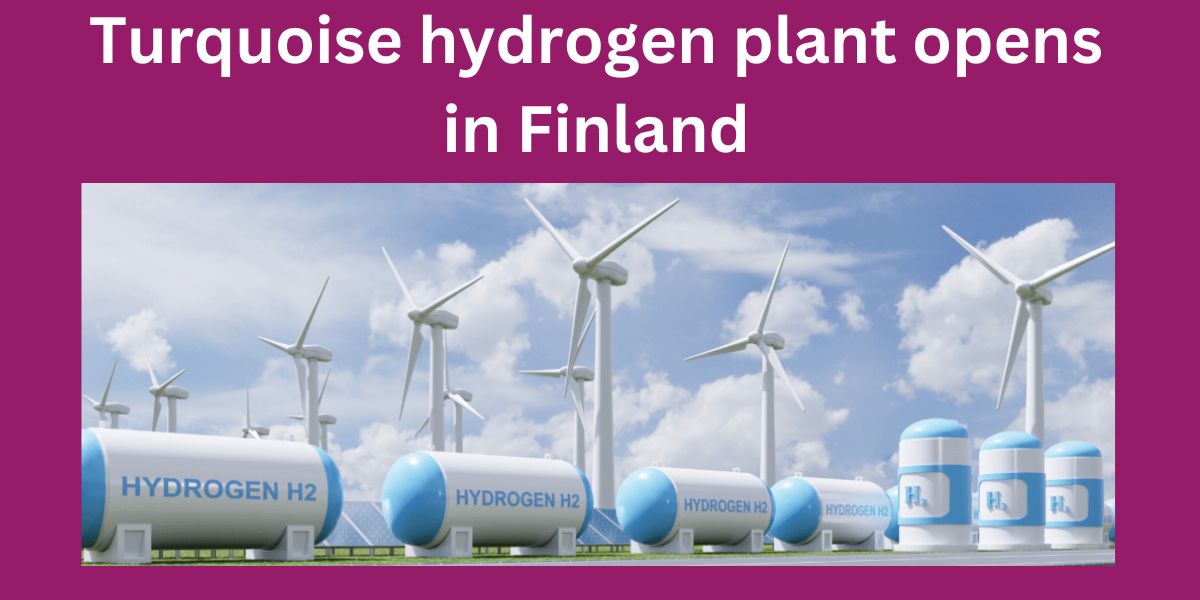Finland, known for its picturesque landscapes and innovative spirit, has recently added another feather to its cap. The much-anticipated turquoise hydrogen plant has officially opened its doors, signaling a significant leap forward in the realm of sustainable energy. But what exactly does this mean for Finland, Europe, and the world? Let’s dive deep into the details and uncover how this groundbreaking development could shape the future of clean energy.
What is Turquoise Hydrogen?
Unveiling the Concept of Turquoise Hydrogen
You might be wondering, what’s so special about turquoise hydrogen? To put it simply, turquoise hydrogen is a cleaner alternative to traditional hydrogen production methods. Unlike gray or blue hydrogen, which rely on fossil fuels and emit carbon dioxide, turquoise hydrogen involves the thermal splitting of methane. This process produces hydrogen and solid carbon, rather than CO2. Think of it as making a smoothie without spilling any juice—clean and efficient!
How Does Turquoise Hydrogen Work?
The process behind turquoise hydrogen is pretty fascinating. It starts with a method called methane pyrolysis. In this reaction, methane (CH4) is heated to very high temperatures, causing it to split into hydrogen (H2) and solid carbon (C). This method not only avoids CO2 emissions but also provides a solid carbon byproduct, which can be used in various industrial applications.
Why Finland?
Finland’s Commitment to Sustainability
Finland has long been a leader in environmental sustainability. From its commitment to renewable energy sources to its aggressive carbon neutrality goals, the country has consistently shown that it’s serious about fighting climate change. The opening of this turquoise hydrogen plant is a testament to Finland’s ongoing efforts to innovate and lead in the green energy sector.
Strategic Location and Advantages
Finland’s geographical location offers unique advantages for this new plant. Its cold climate is ideal for the efficient operation of the hydrogen production process, as lower temperatures can reduce energy consumption. Additionally, Finland’s robust infrastructure and supportive government policies create a favorable environment for such high-tech projects.
The Impact of the Turquoise Hydrogen Plant
Environmental Benefits
The environmental benefits of turquoise hydrogen are impressive. Since this method eliminates CO2 emissions, it significantly reduces the carbon footprint associated with hydrogen production. By adopting this technology, Finland is not only making strides in clean energy but also setting a powerful example for other nations to follow.
Economic and Industrial Opportunities
The opening of the turquoise hydrogen plant is also expected to generate substantial economic benefits. The plant will create jobs, stimulate local economies, and potentially lower the cost of hydrogen production. Moreover, the solid carbon byproduct can be used in various industries, from construction to electronics, further boosting economic activity.
Enhancing Energy Security
By developing its own hydrogen production capabilities, Finland is enhancing its energy security. Hydrogen can be stored and transported more easily than some other forms of energy, making it a versatile and reliable option for future energy needs. This move positions Finland as a leader in hydrogen technology, which could lead to increased energy independence.
Technological Innovations
Cutting-Edge Technologies in the Plant
The turquoise hydrogen plant in Finland is equipped with state-of-the-art technology. The facility features advanced reactors and high-efficiency thermal splitting systems. These innovations ensure that the plant operates at peak efficiency while minimizing energy waste. It’s like upgrading from a regular blender to a high-performance one—better results with less effort!
Collaboration and Research
This plant isn’t a standalone project; it’s part of a broader collaboration between Finland’s government, research institutions, and private companies. This partnership brings together expertise from various fields to push the boundaries of hydrogen technology. It’s like assembling a dream team for a major project—everyone’s skills come together to achieve something extraordinary.
Challenges and Considerations
Technical and Economic Challenges
While the turquoise hydrogen plant represents a significant advancement, it’s not without its challenges. The technology is still relatively new, and scaling it up to meet global demands will require continuous innovation and investment. Additionally, the initial costs of establishing such plants can be high, although the long-term benefits often outweigh these expenses.
Addressing Public Perception
Public perception and acceptance of new technologies can also pose challenges. Educating the public about the benefits of turquoise hydrogen and addressing any concerns will be crucial for the plant’s success. Clear communication and transparency about the plant’s operations and environmental impact will help build trust and support among the community.
The Future of Turquoise Hydrogen
Expanding the Technology
The successful implementation of the turquoise hydrogen plant in Finland could pave the way for similar projects worldwide. As technology advances and becomes more cost-effective, we might see more plants opening in different countries, each contributing to a cleaner and more sustainable global energy landscape.
Innovations on the Horizon
Future innovations could enhance the efficiency and scalability of turquoise hydrogen production. Research is ongoing to improve the thermal splitting process, reduce costs, and develop new applications for the solid carbon byproduct. The possibilities are exciting, and we’re just scratching the surface of what this technology can achieve.
Conclusion
The opening of the turquoise hydrogen plant in Finland marks a pivotal moment in the journey toward sustainable energy. By harnessing the power of advanced technology and committing to clean energy practices, Finland is setting a remarkable example for the world. As we look to the future, the success of this plant could inspire other nations to embrace similar innovations, driving us closer to a greener, more sustainable planet.
FAQs
1. What is turquoise hydrogen?
Turquoise hydrogen is a type of clean hydrogen produced through the thermal splitting of methane, resulting in hydrogen and solid carbon, without emitting CO2.
2. Why is Finland opening a turquoise hydrogen plant?
Finland is opening the plant to advance its sustainability goals, reduce carbon emissions, and lead in innovative energy technologies.
3. How does turquoise hydrogen compare to other types of hydrogen?
Unlike gray or blue hydrogen, turquoise hydrogen does not produce CO2 during its production process, making it a more environmentally friendly option.
4. What are the economic benefits of the turquoise hydrogen plant?
The plant is expected to create jobs, stimulate the local economy, reduce hydrogen production costs, and provide valuable solid carbon byproducts for various industries.
5. How might this plant impact global energy trends?
The success of the turquoise hydrogen plant in Finland could lead to the adoption of similar technologies worldwide, advancing the global shift towards cleaner and more sustainable energy solutions.










